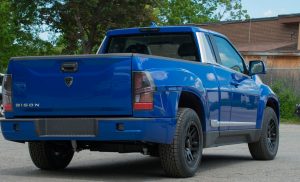New BC electric work vehicle program should be focus of Horgan govt’s zero emission transportation strategy
 Electric work vehicles add value for industry by lowering costs, providing other advantages like better torque
Electric work vehicles add value for industry by lowering costs, providing other advantages like better torque
As a rule, electric vehicle subsidy programs are bad public policy. The American experience nicely illustrates how to tax dollars helping millionaires buy $125,000 Teslas. But a new BC program to boost sales of specialty EVs, especially electric work vehicles like forklifts and school buses, is a much better approach.
The BC announcement isn’t without problems, as illustrated by this comment from George Heyman, minister of environment and climate change strategy: “Significant reductions in transportation emissions will be a central part of our climate strategy. These rebates will help to make the transition more affordable as we work to cut carbon pollution.”
This sort of wooly-headed logic is what leads to wasteful subsidy programs. As the International Energy Agency points out in its recently released World Energy Outlook 2017, even if 100 million EVs are adopted by 2040 they will only displace 1.7 million b/d of oil consumption (by comparison, ever stricter fuel economy standards could cut 17MM b/d).
EVs are a new, immature technology that costs two to three times as much as a gasoline-powered car but only gets 300 to 500 kilometres a charge (assuming normal driving, no hills or extreme weather). Last year global consumers bought just 775,000 EVs out of 88.1 million autos, less than one per new vehicle market share, and 2017 looks to be similar.
BC’s own Clean Energy Vehicle (CEV) Program illustrates the point.
Introduced in 2011, $71 million has been spent over the past six years to subsidize electric and hydrogen-powered vehicles. increase public awareness of CEVs, build infrastructure, and support research.
The number of CEV purchases in that time? Just 4,700. The entire province had less than 5,000 EVs registered as of the end of 2015, according to an email from ICBC, and that number has only risen by a few thousand since. The program also paid for over 1,300 residential and public charging stations (including 30 DC fast charging stations), one new hydrogen fueling station, 10 research and academic curriculum projects.
A 2015 review of the program praised the $14.3 million expended to that point, claiming it was “successful in stimulating demand and encouraging the adoption of clean energy vehicles,” a whole 905 of them over four years.
Sounds like a big expenditure of tax dollars for minimal return. The province tries to spin the money wasted on the program as a good investment, partly to justify the new $40 million announced in the provincial budget
But, as I pointed out earlier this week in a column about Tesla’s new electric semi-truck, work vehicles may be where government should really focus its policy.
In the case of medium and heavy duty trucks, lower costs per kilometre and significantly more torque from electric motors that reduce time spent driving on steep hills are a competitive advantage over diesel trucks.
Work vehicles are the focus of the expanded $2.5-million program BC program..
According to the press release, here are examples of how the incentives can be applied:
- A battery-electric, low-speed Might-E utility truck manufactured by Canadian Electric Vehicles, with a manufacturer’s suggested retail price (MSRP) of $31,170, is eligible for an incentive of $5,000.
- A battery-electric delivery or cube truck manufactured by BYD Auto, with an MSRP of $214,500, is eligible for an incentive of $20,000.
- A battery-electric shuttle bus manufactured by GreenPower Motor Company, priced at $384,500, is eligible for an incentive of $50,000.
Some of the approved companies are based in British Columbia. Favouring local manufacturers is a very good use of public money.
China says it wants to dominate global EV manufacturing in coming years, which is why it subsidizes EV purchases and is considering banning the sale of internal combustion engine cars. The same is true of California, home of Tesla Motors.
If a government is going to subsidize an early-stage industry, why not support companies that pay taxes and wages in that jurisdiction?
In fact, since Canada is late to the electric vehicle and battery manufacturing game, perhaps e-work vehicles – especially those designed to work in severe climates or in natural resource extraction, something Canada and British Columbia have in abundance – could be our nation’s competitive advantage?
Unfortunately, BC’s NDP government appears set to take the wrong strategic approach. A major expansion of the subsidies for electric cars is guaranteed to be unveiled in the near future.
Heyman and the John Horgan Government would accomplish much more and make better use of scarce resources by beefing up the electric work vehicle program and waiting until passenger car EV technology is more mature.
They’ve laid the groundwork with last week’s announcement and it’s not too late to do the smart thing instead of the trendy thing.









